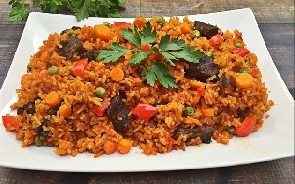 Jollof rice is a West African dish
Jollof rice is a West African dish
Jollof rice may be a delicacy in most of West Africa. But the real home can be a tasty debate. Which is why there has been furore after the United Nations Educational, Scientific and Cultural Organisation (Unesco) declared Senegal as home to the rice-and-fish-based dish.
The UN cultural organisation listed the dish in its Representative List of the Intangible Cultural Heritage of Humanity, signalling just how the Senegalese may have influenced every other variant of Jollof in West Africa.
The move, according to some observers, should have ended years of protracted debate between neighbours Ghana and Nigeria, on who has the best jollof rice.
The most basic form of Jollof rice consists of rice and fish, accompanied by vegetables and most often tomatoes and chilli.
Known for its sweet aroma, deep red colour and spiciness, the dish consists mainly of cooked rice and tomato stew, all cooked in one pot. The tomato gives it the characteristic red colour.
Jollof rice is distinctive due to the spices and seasoning it's prepared with, including onions, peppers and garlic.
In Senegal, the dish is called Ceebu jën. The Unesco list of Intangible Cultural Heritage records a practice, representation, expression, knowledge, or skill considered to be part of a place's cultural heritage, with the aim of ensuring their better protection worldwide and raising awareness of their significance.
The list is published by the Intergovernmental Committee for the Safeguarding of Intangible Cultural Heritage, the members of which are elected by State Parties meeting in a General Assembly.
Jollof rice was listed as part of the 2021 batch of heritages at the 16th session of the committee held virtually from December 13 to 18. The Department of Cultural Heritage in the Ministry of Culture in Senegal is listed as the correspondent in the nomination form shared by the UN agency.
Found throughout Senegal
In their submission, the Senegalese note that the dish is found throughout Senegal, even as Dakar identifies the country’s north western region of Saint-Louis remains the home of the delicacy. The dish is also referred to as ‘Ceebu Ndar’ by some section of Senegalese. The Ndar is the local name for Saint-Louis, itself a Unesco heritage site.
Saint-Louis is thought to be the oldest colonial city on the western African coast and served as the administrative capital of the French West African territories of Mauritania and Senegal during the colonial period.
In large cities in Senegal, Ceebu Jën remains the prized dish of both trendy restaurants and cheap local cafés.
“The Senegalese are great travellers and exported Ceebu Jën to be savoured in their restaurants in the rest of the world, the citation in the Unesco nomination form reads in part. It adds that the name Nigerians and the rest of the world knows the dish for – Jollof Rice - is the historical name for Senegal – “the country of the Wolofs.”
“The Senegalese identify themselves through Ceebu Jën which has several cooking method variants from one region to another. Today, Ceebu Jën is eaten everywhere in the world in Senegalese or African restaurants,” it further states.
More than a regular meal
Known to originate from a region of West Africa called Senegambia (present-day Senegal and Gambia), Jollof Rice is more than a regular meal in these countries.
The dish is also called sometimes Ceebu Jën Penda Mbaye, Penda Mbaye being the name of a legendary cook who is believed to have invented the recipe.
Today, the recipes vary from one region to the next, which is the basis of the so-called battle of culinary supremacy.
The quality of the ingredients — fish and vegetables — is determined by the importance of the event or the degree of affection one has for a guest. The recipe and techniques are traditionally passed down from mother to daughter.
In most Senegalese families, ceebu jën is eaten with the hands, although spoons or forks are usually used in restaurants. The dish is also tied to specific cultural practices. For instance, it is forbidden to sit with a raised knee, the bowl must be held with the left hand, and grains of rice must not be dropped when eating.
“The ceebu jën dish and associated practices are viewed as an affirmation of Senegalese identity,” says Unesco.
The debate between Nigerians and Ghanaians provokes such high emotion that it usually surfaces in every competition involving nationals of the two countries.